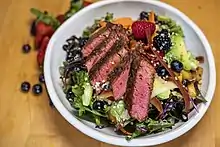Meat analogue
A meat analogue is a meat-like substance made from plants. More common terms are plant-based meat, vegan meat, meat substitute, mock meat, meat alternative, imitation meat, or vegetarian meat, or, sometimes more pejoratively, fake meat or faux meat. Meat analogues typically approximate certain aesthetic qualities (such as texture, flavor, appearance) or chemical characteristics of specific types of meat. Generally, meat analogue means a food made from vegetarian ingredients, and sometimes without animal products such as dairy. Many analogues are soy-based (e.g. tofu, tempeh) or gluten-based, but now may also be made from pea protein. Other less common analogues include ingredients like mycoprotein.
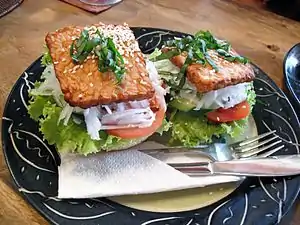
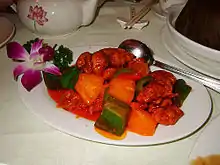


Because of their similarity to meats, they are frequently used in dishes and food practices similar to meat. The target market for meat analogues includes vegetarians, vegans, non-vegetarians seeking to reduce their meat consumption,[1][2] and people following religious dietary laws in Hinduism, Judaism, Islam, and Buddhism.
Increasingly, the global demand for sustainable diets in response to the outsized role animal products play in global warming and other environmental impacts has seen an increase in industries focused on finding substitutes similar to meat. However, the motivation for seeking out mock meats tends to vary depending on consumer group. The market for meat alternatives is highly dependent on "meat-reducers" — a consumer group who is primarily motivated by health consciousness and weight management. Consumers who identify as vegan, vegetarian or pescetarian are more likely to endorse concerns regarding animal welfare and/or environmentalism as primary motivators.[2][3]
Meat substitution has a long history. Tofu, a popular meat analogue made from soybeans, was known in China during the period of the Western Han dynasty (206 BCE – 9 CE).[4] A document written by Tao Gu (903–970) describes how tofu was called "small mutton" and valued as an imitation meat. Meat analogues such as tofu and wheat gluten are associated with Buddhist cuisine in China and other parts of East Asia.[5] In Medieval Europe, meat analogues were popular during the Christian observance of Lent, when the consumption of meat from warm-blooded animals is forbidden.[6]
In the 2010s, owing to concern over global warming, human population size, and major investments by companies such as Impossible Foods and Beyond Meat, there was an increase in awareness and the market size for meat analogues in Western and Westernized markets.
History
Tofu, a popular meat analogue, was invented in China by the Han dynasty (206 BC–220 AD). Drawings of tofu production have been discovered in a Han dynasty tomb.[4][7] Its use as a meat analogue is recorded in a document written by Tao Gu (simplified Chinese: 陶谷; traditional Chinese: 陶穀; pinyin: Táo Gǔ, 903–970). Tao describes how tofu was popularly known as "small mutton" (Chinese: 小宰羊; pinyin: xiǎo zǎiyáng), which shows that the Chinese valued tofu as an imitation meat. Tofu was widely consumed during the Tang dynasty (618–907), and likely spread to Japan during the later Tang or early Song dynasty.[4]
Wheat gluten has been documented in China since the 6th century.[8] The oldest reference to wheat gluten appears in the Qimin Yaoshu, a Chinese agricultural encyclopedia written by Jia Sixie in 535. The encyclopedia mentions noodles prepared from wheat gluten called bo duo.[8] Wheat gluten was known as mian jin by the Song dynasty (960–1279).
Prior to the arrival of Buddhism, northern China was predominantly a meat consuming culture. The vegetarian dietary laws of Buddhism led to development of meat analogues as a replacement for the meat-based dishes that the Chinese were no longer able to consume as Buddhists. Meat analogues such as tofu and wheat gluten are still associated with Buddhist cuisine in China and other parts of East Asia.[5] Meat analogues were also popular in Medieval Europe during Lent, which prohibited the consumption of warm-blooded animals, eggs, and dairy products. Chopped almonds and grapes were used as a substitute for mincemeat. Diced bread was made into imitation cracklings and greaves.[6]
John Harvey Kellogg developed meat replacements variously from nuts, grains, and soy, starting around 1877, to feed patients in his vegetarian sanitarium.[9]
There was an increased interest in meat analogues during the late nineteenth century and first half of the twentieth century.[10] Prior to 1950, interest in meat analogues came from vegetarians searching for alternatives to meat protein for ethical reasons and regular meat-eaters who were confronted with food shortages during World War I and World War II.[10]
Dietitian Sarah Tyson Rorer authored the cookbook, Mrs. Rorer's Vegetable Cookery and Meat Substitutes in 1909.[11] The book includes a mock veal roast recipe made from lentils, breadcrumbs and peanuts.[11] In 1945, Mildred Lager commented that soybeans "are the best meat substitute from the vegetable kingdom, they will always be used to a great extent by the vegetarian in place of meat."[12]
Meat analog products are currently made by two basic processes, through either thermoplastic extrusion or fiber spinning. Thermoplastic extrusion involves the adaptation of production processes that are more commonly associated with the making of ready-to-eat cereal products. Extruders are considered to be a cost-effective method of accommodating large-scale productions, and for forming desirable fibers.[13]
Types
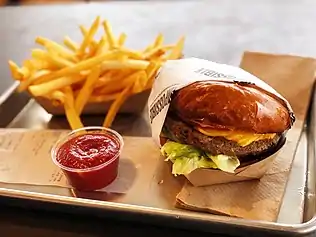
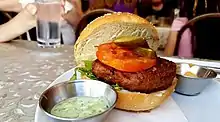
Some vegetarian meat analogues are based on centuries-old recipes for seitan (wheat gluten), rice, mushrooms, legumes, tempeh, yam flour or pressed-tofu, with flavoring added to make the finished product taste like chicken, beef, lamb, ham, sausage, seafood, etc. Other alternatives use modified defatted peanut flour, yuba and textured vegetable protein (TVP); yuba and TVP are both soy-based meat analogues, the former made by layering the thin skin which forms on top of boiled soy milk,[14] and the latter being a dry bulk commodity derived from soy and soy protein concentrate. There is also algae powder (i.e. made from such algae such as Chlorella, Spirulina, ...).[15] Some meat analogues include mycoprotein, such as Quorn which usually uses egg white as a binder. Another type of single cell protein-based meat analogue (which does not use fungi however but rather bacteria[16]) is Calysta.
Composition
.jpg.webp)
Soy protein isolates or soybean flour and gluten are usually used as foundation for most meat analogs that are available on the market. Soy protein isolate is a highly pure form of soy protein with a minimum protein content of 90%. The process of extracting the protein from the soybeans starts with the dehulling, or decortication, of the seeds. The seeds are then treated with solvents such as hexane in order extract the oil from them. The oil-free soybean meal is then suspended in water and treated with alkali to dissolve the protein while leaving behind the carbohydrates. The alkaline solution is then treated with acidic substances in order to precipitate the protein, before being washed and dried. The removal of fats and carbohydrates, results in a product that has a relatively neutral flavor.[17] Soy protein is also considered a "complete protein" as it contains all of the essential amino acids that are crucial for proper human growth and development.[18]
Lipids are added to the meat analog in the form of liquid or semi-liquid glyceride shortening from synthesis, or other sources such as plants or animals. The glycerides could potentially contain unsaturated or saturated long chain acyl radicals ranging from 12 to around 22 carbon atoms. Due to the target audience of meat analogs, plant based lipid sources such as soybean oil, olive oil, canola oil, and others alike are usually used.[19] While lipids do not contribute to the structure of the meat analog, it is crucial in increasing the palatability and broadening the appeal of the product across the consumer base.
Food additives include flavor compounds, coloring agents, leavening agents, and emulsifiers. Sodium bicarbonate is a commonly used leavening agent in a variety of baked products such as bread and pancakes. The carbon dioxide released by sodium bicarbonate aids in the expansion and the unilateral stretching of the protein network during production. A variety of emulsifiers can be used to stabilize the meat analog system. These could include, but are not limited to polyglycerol monoesters of fatty acids, monoacylglycerol esters of dicarboxylic acids, sucrose monoesters of fatty acids, and phospholipids. Polyglycerol monoesters consist on average of 2 to 10 glycerol units and an average of one acyl fatty acid group per glycerol component. The polymer is created from esterification reactions with fatty acids and contains 14 to 16 carbons per polyglycerol moiety. Sucrose monoesters are derived from the esterification of sucrose with a fatty acid ester or a fatty acid and it ideally should have a fatty acyl group ranging from 14 to 18 carbon atoms. Lastly, phospholipid such as lecithin, cephalin, and sphingomyelin can also be used as effective emulsifiers.[19] In addition, some of the emulsifier act as a lubricant during the extrusion process.
Overall the composition of dry protein mix can contain between 30% to 100% water-hydratable, heat-coagulable protein by weight. A dry mix that contains 100% protein content yields the most desirable fibrous texture, but from the palatability standpoint between 50% to 70% was determined to generate the most positive feedback.[19] Protein content of lower than 30% would inhibit the formation of meat-like fibers during processing. The optimal fat content for the desirable mouth feel was determined to be around 30% to 40% by weight.
Commerce
In April 2013, Beyond Meat began selling Beyond Chicken in Whole Foods Market stores in the US. A mixture of soy and pea proteins, fiber, and other ingredients, the well-received product was marketed as an alternative to chicken meat. The California-based company developed a number of other imitation meat products including three different products to mimic beef and one to mimic pork sausage.
In 2016, Impossible Foods introduced a beef substitute, which it claimed offered appearance, taste and cooking properties similar to meat.[20] In April 2019, Burger King introduced a new product, the Impossible Whopper which was released nationwide later that year,[21] becoming one of the most successful product launches in Burger King's history.[22] By October 2019, restaurants, such as Carl's Jr, Hardee's, A&W, Dunkin Donuts, and KFC were selling meat analogue products.[23] Nestlé entered the plant-based burger market in 2019 with the introduction of the "Awesome Burger".[24] Kellogg's Morningstar brand tested its new Incogmeato line of meatless meat-like products in early September 2019, with plans for a nationwide rollout in early 2020.[25]
These vegan meats are consumed in restaurants, grocery stores, bakeries, vegan school meals, and in homes. The sector for plant-based meats grew by 37% in North America over 2017–18.[26] In 2018–19, sales of plant-based meats in the United States were $895 million,[27] with the global market for meat analogues forecast to be $140 billion by 2029.[28] Seeking a healthy alternative to meat, curiosity, and trends toward veganism were drivers for the meat analogue market in 2019.[29] The changing importance of the meat analogues in the American diet was visible in the dramatic increase in purchases during the COVID-19 pandemic in the United States.[30] The book The End of Animal Farming by Jacy Reese Anthis argues that plant-based food and cultured meat will completely replace animal-based food by 2100.[31]
The types of ingredients that can be used to create meat analogs is expanding, from companies like Plentify, which are using high-protein bacteria found in the human microbiome,[32] to companies like Meati Foods, that are cultivating the mycelium of fungi to form steaks, chicken breasts, or fish.[33] Moving away from plant-based meat analogs due to the efficiency of the prokaryotic and fungi kingdoms may occur in the future as these nascent niched industries continue to grow.
Criticism
Meat analogue companies, including Impossible Foods and Beyond Meat, have been criticized for their marketing and makeup of their products. Dietitians have claimed they aren't necessarily healthier than meat due to their highly processed nature and sodium content.[34][35]
John Mackey, co-founder and CEO of Whole Foods, and Brian Niccol, CEO of Chipotle Mexican Grill, have criticized meat analogues for being ultra-processed. Chipotle has claimed it won't carry these products at their restaurants due to their highly processed nature. According to CNBC, "Chipotle joins the likes of Taco Bell — Niccol's former employer — and Arby's in committing to excluding meatless meats on its menu."[36] In response, Beyond Meat invited Niccol to visit its manufacturing site to see the production process.[36]
See also
- Egg substitutes
- List of bacon substitutes
- List of meat substitutes
- List of vegetarian and vegan companies
- Food vs. feed
- Leghemoglobin: alters flavor of certain meat analogues to make them taste even more similar to meat ("simulates" animal blood in these meat analogues, but made from plant-based sources).
- Nut roast, an alternative to a Sunday roast
- Nuteena, former (until 2005) vegetarian meat analogue made primarily from peanut meal, soy, corn, and rice flour
- Milk substitute
- Precision fermentation
- Single-cell protein, meat analogues containing protein extract from pure or mixed cultures of algae, yeasts, fungi or bacteria or made from air
- Tofurkey, faux turkey, a meat substitute in the form of a loaf or casserole of vegetarian protein, usually made from tofu (soybean protein) or seitan (wheat protein) with a stuffing made from grains or bread, flavored with a broth and seasoned with herbs and spices
References
- Schwab, Katharine (2019-07-25). "These plant-based food companies are rebranding to target meat eaters—and it's working". Fast Company. Retrieved 2020-09-03.
- "CONSUMER INSIGHTS" (PDF). AHDB. July 2018. Retrieved September 2, 2020.
- Penny, J. C.; Swift, J. A.; Salter, A. M. (2015). "'Meat reducers': meat reduction strategies and attitudes towards meat alternatives in an emerging group". Proceedings of the Nutrition Society. 74 (OCE5). doi:10.1017/S0029665115003602. ISSN 0029-6651.
- DuBois, Christine; Tan, Chee-Beng; Mintz, Sidney (2008). The World of Soy. National University of Singapore Press. pp. 101–102. ISBN 978-9971-69-413-5.
- Anderson, E.N. (2014). "China". Food in Time and Place. University of California Press. p. 44. ISBN 978-0-520-95934-7.
- Adamson, Melitta Weiss (2004). Food in Medieval Times. Greenwood Publishing Group. p. 72. ISBN 978-0-313-32147-4.
- William Shurtleff; Akiko Aoyagi (18 December 2014). History of Meat Alternatives (965 CE to 2014): Extensively Annotated Bibliography and Sourcebook. Soyinfo Center. ISBN 978-1-928914-71-6.
- Shurtleff, William; Aoyagi, Akiko; Huang, H.T. (2014). History of Soybeans and Soyfoods in China and Taiwan, and in Chinese Cookbooks, Restaurants, and Chinese Work with Soyfoods Outside China (1024 BCE to 2014). Soyinfo Center. pp. 2478–2479. ISBN 978-1-928914-68-6.
- "Dr. John Harvey Kellogg and Battle Creek Foods". www.soyinfocenter.com.
- Perren, Richard. (2017). Taste, Trade and Technology: The Development of the International Meat Industry Since 1840. Routledge. pp. 188-190. ISBN 978-0-7546-3648-9
- Shprintzen, Adam D. (2013). The Vegetarian Crusade: The Rise of an American Reform Movement, 1817-1921. University of North Carolina Press. pp. 137-138. ISBN 978-1-4696-0891-4
- Lager, Mildred M. (1945). The Useful Soybean: A Plus Factor in Modern Living. McGraw-Hill Book Company. p. 95
- Alam, M. S.; Kaur, Jasmeen; Khaira, Harjot; Gupta, Kalika (9 January 2015). "Extrusion and Extruded Products: Changes in Quality Attributes as Affected by Extrusion Process Parameters: A Review". Critical Reviews in Food Science and Nutrition. 56 (3): 445–473. doi:10.1080/10408398.2013.779568. ISSN 1040-8398. PMID 25574813. S2CID 46127447.
- Patterson, Daniel (2006-08-06). "The Way We Eat: I Can't Believe It's Tofu". The New York Times. Retrieved 2009-02-26.
- Rack, Jessie (August 11, 2015). "Protein Goes Green: Can Algae Become The Next Soy?". NPR.
- EOS, April 2019, page 52
- Sedgwick, Tali (June 28, 2013). "Meat Analogs". Food and Nutrition. Academy of Nutrition and Dietetics. Retrieved December 10, 2016.
- US patent 5285709, Robert A. Boyer, "Meat Analog Compositions.", issued 1954-06-29
- US patent 3814823, Yang J. and R. Olsen, "Meat Analogs Having the Fiber Structure of Meat.", issued 1974-06-04
- Reilly, Michael (June 22, 2016). "Fake meat companies might finally cure our addiction to animal flesh". Technology Review. Retrieved 2016-07-28.
- Popper, Nathaniel (2019-04-01). "Behold the Beefless 'Impossible Whopper'". The New York Times. Retrieved 2019-04-03.
- Chiorando, Marie (17 November 2019). "Impossible Whopper Is 'One Of Burger King's Most Successful Launches In History'". Plant Based Newws. Retrieved 7 February 2020.
- Rivera, Dane (22 October 2019). "All The Major Fast Food Chains And Markets Selling Beyond Meat and Impossible Foods". Uproxx. Retrieved 10 January 2020.
- Wiener-Bronner, Danielle (24 September 2019). "The Awesome Burger is Nestlé's answer to the plant-based meat craze". CNN Business. Cable News Network. Retrieved 7 February 2020.
- Chung, Heidi (February 12, 2020). "Food giant Kellogg's unveils 'Incogmeato' plant-based products". Yahoo! Finance.
- Olayanju, Julia B. (30 July 2019). "Plant-based Meat Alternatives: Perspectives On Consumer Demands And Future Directions". Forbes. Retrieved 10 January 2020.
- Cheng, Andria (29 July 2019). "Beyond Meat Q2 Sales Quadruple, But Replacing Meat? That's A Different Story". Forbes. Retrieved 10 January 2020.
- Franck, Thomas (23 May 2019). "Alternative meat to become $140 billion industry in a decade, Barclays predicts". CNBC. Retrieved 10 January 2020.
- Mourdoukoutas, Panos (31 August 2019). "Veganism And Vegetarianism Are Changing Fast Food". Forbes. Retrieved 10 January 2020.
- "America's Shopping List: Here's What We're Buying The Most". NPR. Retrieved 2020-03-21.
- Reese, Jacy (6 November 2018). The End of Animal Farming: How Scientists, Entrepreneurs, and Activists are Building an Animal-Free Food System. Boston: Beacon Press. ISBN 9780807039878.
- Watson, Elaine (20 June 2020). "'Plentify' novel single cell protein 'ludicrously efficient' to produce vs animal protein, claims startup". Retrieved 2020-06-26.
- Peters, Adele (2019-10-29). "If it looks like a steak and tastes like a steak, in this case, it's a mushroom". Fast Company. Retrieved 2020-06-26.
- Lucas, Amelia (2019-07-04). "Are Beyond Meat's plant-based burgers healthier than red meat? Dietitians say no". CNBC. Retrieved 2020-09-02.
- Drayer, Lisa (2019). "They might be better for the planet, but are plant-based burgers good for you?". CNN Health. Retrieved 2020-09-02.
- Lucas, Amelia (2019-07-24). "Beyond Meat CEO invites Chipotle for a tour after its fake meats are called too processed". CNBC. Retrieved 2020-09-02.
| Wikimedia Commons has media related to Meat substitutes. |
